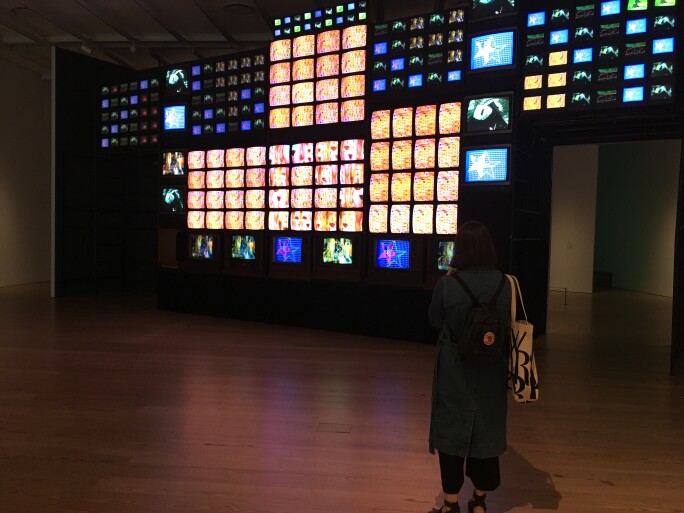
Exhibition view of Programmed: Rules, Codes, and Choreographies in Art, 1965-2018, Whitney Museum of American Art, 2018.
Programmed:
Rules, Codes, and Choreographies in Art
The Whitney’s latest exhibition Programmed: Rules, Codes, and Choreographies in Art, 1965-2018 focuses on a timely, urgent theme: the nature of and role that programming – specifically, instructions – play in the modern world. The exhibition gathers works from the Whitney’s collection that are either programmed themselves or that engage directly with programming and concepts relating to it. The exhibition therefore draws attention to the ways in which programming, instructions, and artificial intelligence function and shape our lives.
Crucially, it also forces the viewer to consider the vulnerabilities and fragility of such systems and their underlying structures and instructions. Given the increasingly prominent role that artificial intelligence plays in our lives and the systems and technology that guide them, Programmed is a particularly urgent, relevant exhibition and a perfect setting in which to consider some of the most pressing questions of our time.

Nam June Paik, Fin de Siecle II, 1989. Seven-channel video installation (partially restored), 207 televisions, sound.
The centerpiece of the exhibition is the huge, newly restored, multi-channel 1989 installation Fin de Siecle II by Nam June Paik. The work has not been displayed since the original 1989 Whitney Museum exhibition for which it was created. The Whitney's conservation team has since meticulously restored the piece, replacing several televisions with equivalent units from the 1980s and the processor which controls the work's numerous video and sound channels. The seven-channel work consists of 207 televisions, all of which are older, cathode-ray tube models from the time of the work's creation.

Nam June Paik, detail of Fin de Siecle II, 1989.
The tremendous size and complexity of the piece is immediately overwhelming; the multiple channels of the work each project different but related loops of video. A complicated, layered soundtrack accompanies the video, compounding the already overwhelming sensory experience that the piece generates. By creating such a complicated work, consisting of so many different sources of sound and video, Paik succesfully condenses and replicates the contemporary experience of being constantly faced with distracting information sources, visually and sonically. Paik is generally considered to have been one of the inventors and pioneers of video art; Fin de Siecle II demonstrates the continuing relevance of his formal innovations and thematic preoccupations.

Joseph Kosuth, Five Words in Green Neon, 1965. Neon.
Paik's piece also plays the role of splitting the exhibition between two thematic divisions. The first of these - with works by Josef Albers, Donald Judd, and other mid-century masters - focuses on "instructions, rules, and algorithms", placing a particular emphasis on "conceptual art practices". The second focuses on "the use of instructions and algorithms to manipulate" television programs, sets and signals, or image sequences.

Donald Judd, Untitled, 1965. Aluminum with nitrocellulose lacquer.
Judd's key work in the show is his sculpture Untitled from 1965, which consists of ten purple aluminum boxes attached to a silver bar. The gaps between these boxes are determined by the size of the boxes on the opposite side of the piece. The boxes and the gaps therefore meet in the middle, creating a visual and spatial loop and thus functioning according to a specific instruction.
The work has not been displayed publicly since since its acquisition and, as with Paik's Fin de Siecle II, the Whitney's conservation team needed to do extensive work on the piece to bring it to an exhibition-worthy state. This included conducting a lengthy search for the exact shade of purple that Judd used to paint the boxes back in 1965.

Jim Campbell, Tilted Plane, 2011. Custom LED light bulbs and electronics.
Programmed includes dozens of remarkable and timely works, all of which engage with various forms of technology from the past four decade - from 1980s televisions to augmented reality apps on iPads that present the world as if one was underwater.
The exhibition, on view through 14 April 2019, is both visually and conceptually compelling; its concerns with modern day culture should align neatly with those of the vast forthcoming Andy Warhol retrospective opening at the Whitney in early November.